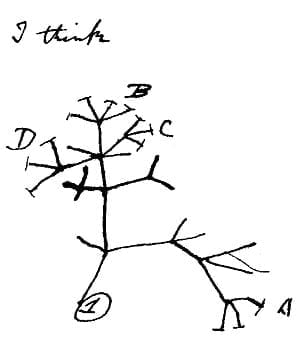The Brazilian higher education establishment was somewhat flabbergasted in early October when an official event at a Federal University – maintained with public funding – presented, as its opening speech, a hearty defense of Creationism and an attack on the theory of evolution.
The keynote speaker, Marcos Eberlin, was a retired Chemistry professor from yet another public Brazilian University, and leads the Brazilian branch of the American Creationist think-tank Discovery Institute. The branch is new, officially launched in 2017.
As a matter of fact, during most of the 20th century, the Creation-Evolution “debate” had never been an issue in Brazilian education and academia. With an overwhelmingly Catholic population, Brazil kept its Church-State frictions focused more on sex-related (or “moral”) issues such as divorce law and contraception, rather than scientific ones.

Demographic changes that came to the fore in the 1990s, with the growing popularity of Evangelical churches of North American inspiration, changed that, though.
And now, “Creation Science” and “Intelligent Design” are attempting to make up, in Brazil, for the territory lost in the USA, where a landmark court decision (Edwards v. Aguillard, 1987) ruled against the teaching of Creationism in state-funded schools.
In Brazil, the movement has started to gain momentum in the past couple of decades. In 2008, the then Minister of the Environment, Marina Silva, was scolded for taking part in a Creationist event. This would be used against her later, when she ran for President in 2014.
In that same year, a Member of Parliament, Marco Feliciano, proposed a bill to make the teaching of Creationism mandatory in all state schools. The bill never came to a vote.
Unfortunately, things have gathered pace under the present government. The current administration placed an avowed Creationist, Benedito Guimarães Aguiar Neto – one of the people responsible for bringing Discovery Institute to Brazil – as president of CAPES, the Federal agency in charge of Brazil’s higher education.
Damares Alves, Minister of Human Rights and Women Issues, has publicly deplored the teaching of Evolution in state schools, without suffering more than a fraction of the backlash felt by Marina Silva 12 years ago.
This changing landscape poses a challenge to scientists, skeptics and teachers. In the current polarized landscape, it’s all too easy to see the growth of Creationism as a political issue, which it is, and forget that it’s also a communication and education issue. The reason creationism was not a big deal in Brazil in the 20th century was not because everybody understood and accepted evolution, but because very few people had reason to give it much thought, or any thought at all.
With the rise of “Intelligent Design”, disguised as science, creationism has been slowly infiltrating our schools, and again, Brazilian scientific community has turned a blind eye, and will probably only realise their mistake once it’s too late to fix it.
Why is “Intelligent design” so much easier to sell than plain creationism? And what exactly is at stake when we allow religion into our science classes? There is nothing wrong with religious beliefs, but while we scientists don’t go to religious temples demanding that they stop preaching about God creating the world, we don’t want religion disguised as science telling our children that evolution is not real.
Intelligent design (ID) has all the characteristics of classic pseudoscience. It uses scientific language, and scientific facts, and twists the results to prove a point. There are no questions, just truths that need “scientific” background. It also takes advantage of common misconceptions about evolution and natural selection.

ID offers no scientific explanation for the origin of species. In fact, it has no interest in science at all, it is completely focused on debunking the theory of evolution, claiming that several systems contain what they call “irreducible complexity”. This means that they are far too complex for evolution, and therefore must have been designed by a higher power.
The most common example used to illustrate this idea is a mousetrap. One of ID’s most dedicated promoters, Michael Behe, argues that the mousetrap is made up of parts that have no function alone, and thus could not have been “selected for” in an evolutionary process. He uses real concepts, such as survival of the fittest, and the idea that any mutation that gives us an advantage will be favoured by natural selection, and twists them in a way so that the explanation makes sense. Why would natural selection favour parts of the mousetrap – or of a living organism – that don’t seem to confer any advantage?
Behe ignores the fact that evolution is not driven. Organisms do not evolve with a purpose. Unlike the parts of a mousetrap, which are specifically designed to be turned into a mousetrap, mutations that make hair grow are not grooming the animal for winter – no pun intended. Mutations are random, and hairy animals stand a better chance to survive in cold weather. Such mutations could come from features that have been an advantage in another capacity, or could have been no advantage at all. As long as they aren’t deleterious, they won’t be selected out.
ID proponents also ignore that evolution is not just about natural selection and random mutations. It involves genetic drift and horizontal gene transfer. Bacteria “trade” genes all the time, and we have evidence of gene transfer having occurred in plants and humans too. And then there is genetic drift, when a gene is fixed randomly in a population regardless of fitness, but purely by chance. Natural cataclysms are a good example: imagine a situation where there are two separate populations of a species, one with blue eyes, the other brown. Blue eyes lived on an island that was destroyed by an earthquake. Brown eyes do not confer any advantage, but now the blue-eyed population is gone, and brown eyes become predominant.
The fact is that ID, like most pseudosciences, preys on our scientific misconceptions. If we don’t teach science as a process, and don’t teach our students to think rationally, they will be easily fooled by pseudoscientific claims. If we don’t fully understand evolution, we will be vulnerable to ID. If we don’t fully understand the rational process of drug testing, we will be vulnerable to alternative medicine.
ID was kicked out of the US educational system twenty years ago, but it is now finding fertile ground in Brazil. It makes us wonder if we are not making ourselves too vulnerable to all kinds of magical thinking by refusing to take science and education seriously.


